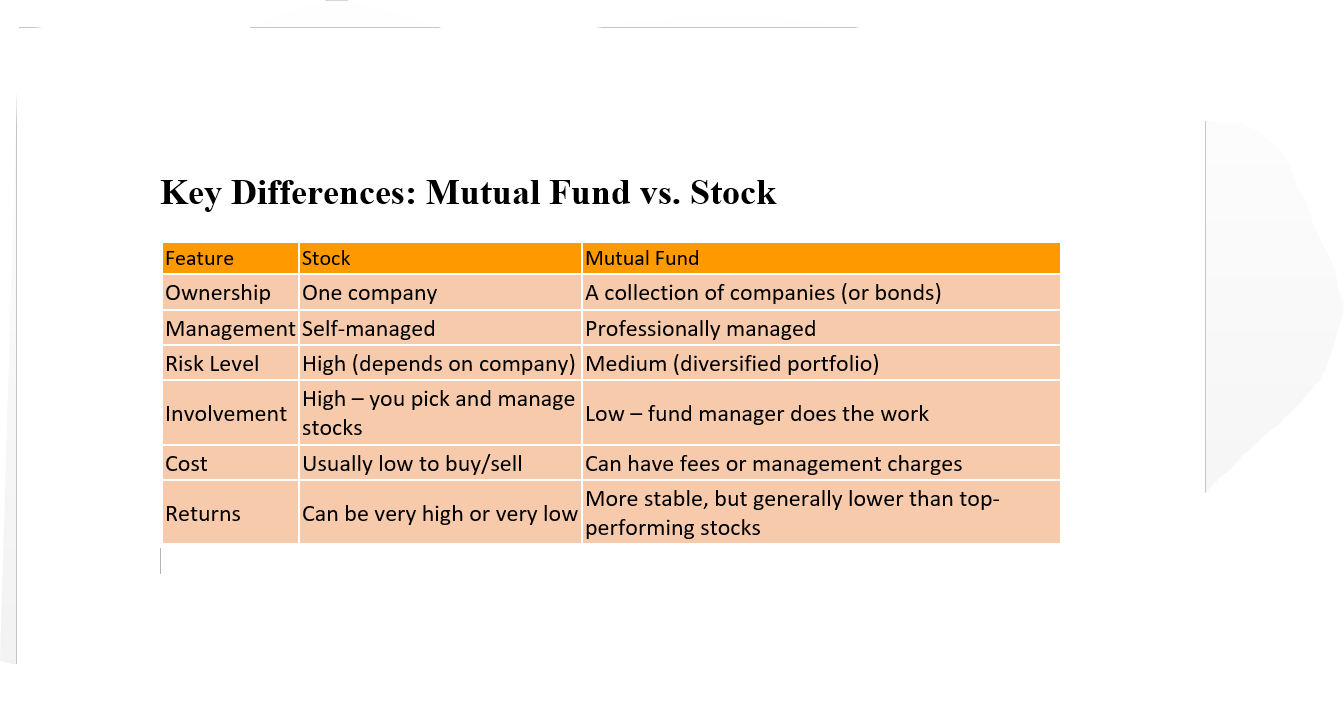Mutual Funds vs. Stocks: Which One Is Right for You?
If you’re trying to figure out how to grow your money, you’ve likely heard about mutual funds and stocks. These two investment options pop up everywhere — on financial news, in retirement plans, or in casual chats with friends trying to be the next Warren Buffett.
But what do they actually mean? And which one is better for you?
Whether you’re just starting your investment journey or trying to get smarter about where to put your money, this guide breaks it all down — clearly, simply, and thoroughly.
What Is a Stock?
A stock represents a small slice of ownership in a company. When you buy a stock, you’re buying a piece of that company — no matter how tiny that piece is.
Example: If you buy a share of Apple, you own a small part of Apple Inc. If the company grows and profits, the value of your share may rise. If it struggles, your share could lose value.
How You Make Money With Stocks
There are two main ways:
Price Increase (Capital Gains) – If you buy a stock for $100 and it rises to $150, you’ve made $50.
Dividends – Some companies pay out a portion of their profits to shareholders regularly.
The Risks
Stocks can be very volatile. A company’s stock price can swing wildly in a short period.
You could lose money if the company performs poorly or if the market crashes.
What Is a Mutual Fund?
A mutual fund pools money from many investors and invests it in a mix of assets — usually stocks, bonds, or both. A professional manager handles all the buying and selling.
Example: Imagine a basket with 100 different company stocks inside it — Apple, Microsoft, Google, Coca-Cola, etc. When you buy a mutual fund, you’re buying a piece of that whole basket, not just one company.
How You Make Money With Mutual Funds
Increase in Fund Value – If the value of the investments in the fund rises, your share in the fund becomes more valuable.
Dividends and Interest – If the fund holds dividend-paying stocks or interest-paying bonds, that income can be passed on to you.
The Risks
Mutual funds can still lose money, especially if the market goes down.
Fees can eat into your profits if you’re not careful.

Can You Invest in Both?
Absolutely. In fact, many smart investors do.
Example Strategy: You could put 70% of your money in mutual funds for stability and long-term growth, and 30% in individual stocks where you see opportunity.
This mix gives you both the safety of diversification and the thrill of picking winning stocks.
Real-Life Example
Let’s say you have ₹10,000 (or $10,000) to invest.
Option 1: You buy 100 shares of a startup tech company at ₹100 each. If the company does well and the stock doubles, you make ₹10,000 in profit. But if it crashes, you could lose it all.
Option 2: You invest in a mutual fund that holds 50 different stocks. If some go up and some go down, you might still end up with a 10–12% return over the year. Not as dramatic, but more predictable.
Common Myths Busted
“Stocks are like gambling.”
Not if you know what you’re doing. Investing in solid companies based on research is very different from betting on roulette.
“Mutual funds are always safe.”
They’re safer than individual stocks, but not risk-free. They can still lose value during market downturns.
“You need a lot of money to invest.”
Not true. Many mutual funds allow you to start with as little as ₹500 per month (via SIPs in India), and you can buy fractional stocks through many platforms.
Final Thoughts
There’s no one-size-fits-all answer. Stocks and mutual funds both have their place in a smart investment plan.
If you’re just starting out and don’t want to worry about the daily ups and downs of the market, mutual funds are a great place to begin. As you grow more confident, you can start exploring stocks — especially in industries or companies you believe in.
The most important step? Start. Whether it’s ₹500 or ₹50,000, get your money working for you. Time in the market beats timing the market — always.
